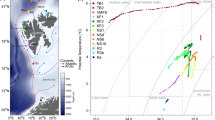Abstract
Abundance and distribution of calanoid resting eggs in sediment were examined in 1988–1989 in an enclosed marine basin (Svartatjønn; western Norway). The basin undergoes rotenone treatment and draining every winter. Egg densities were highest in autumn, when up to 2 × 106 eggs m−2 were found, and lowest in summer. Egg densities were also highest in the deeper parts of the basin and in the upper 1 cm of sediment. Hatching was initiated in late January by pumping warmer deep water from the outside area into the basin. Evidence is given for resting-egg formation inEurytemora affinis Poppe, 1880 andAcartia clausi Gurney, 1931 (present phenotype reclassified asA. teclae by Bradford 1976: N. Z. Jl mar. Freshwat. Res. 10: 159–202). Seasonal differences in inhibition of hatching, together with the longevity and tolerance of these eggs, strongly suggest that they are diapause eggs.
Similar content being viewed by others
Literature cited
Bradford, J. M. (1976). Partial revision of theAcartia subgenusAcartiura (Copepoda: Calanoida: Acartiidae). N. Z. Jl mar. Freshwat. Res. 10: 159–202
Grice, G. D., Marcus, N. H. (1981). Dormant eggs of marine copepods. Oceanogr. mar. Biol. A. Rev. 19: 125–140
Gurney, R. (1931). British freshwater Copepoda, Vol. I. Ray Society, London
Kajak, Z. (1971). Benthos of standing water, Chap. 3. In: Edmondson, W. T., Winberg, G. G. (eds.) A manual on methods for the assessment of secondary productivity in fresh waters. IBP Handbook no. 17. Blackwell Scientific Publications, Oxford, p. 25–65
Kasahara, S., Uye, S., Onbé, T. (1975). Calanoid copepod eggs in sea-bottom muds. II. Seasonal cycles of abundance in the populations of several species of copepods and their eggs in the inland Sea of Japan. Mar. Biol. 31: 25–29
Katona, S. K. (1970). Growth characteristics of the copepodsEurytemora affinis andE. herdmani in laboratory cultures. Helgoländer wiss. Meeresunters. 20: 373–384
Lindley, J. A. (1986). Dormant eggs of calanoid copepods in sea-bed sediments of the English Channel and southern North Sea. J. Plankton Res. 8: 399–400
Lindley, J. A. (1990). Distribution of overwintering calanoid copepod eggs in sea-bed sediments around southern Britain. Mar. Biol. 104: 209–217
Marcus, N. H. (1989). Abundance in bottom sediments and hatching requirements of eggs ofCentropages hamatus (Copepoda: Calanoida) from the Alligator Harbor region, Florida. Biol. Bull. mar. biol. Lab., Woods Hole 176: 142–146
Marcus, N. H. (1990). Calanoid copepod, cladoceran, and rotifer eggs in sea-bottom sediments of northern Californian coastal waters: identification, occurrence and hatching. Mar. Biol. 105: 413–418
Næss, T. (1991). Ontogenic and sex dependent rotenone tolerance of a marine copepod,Acartia clausi Giesbrecht. Sarsia 76: 29–32
Schindler, D. W. (1969). Two useful devices for vertical plankton and water sampling. J. Fish. Res. Bd Can. 26: 1948–1955
Uye, S. (1980). Development of neritic copepodsAcartia clausi andA. steuri, I. Some environmental factors affecting egg development and the nature of resting eggs. Bull. Plankton Soc. Japan 27: 1–9
Uye, S. (1982). Population dynamics and the production ofAcartia clausi Giesbrecht (Copepoda: Calanoida) in inlet waters. J. exp. mar. Biol. Ecol. 57: 55–83
Uye, S. (1985). Resting egg production as a life history strategy of marine planktonic copepods. Bull. mar. Sci. 37: 440–449
Uye, S., Fleminger, A. (1976). Effects of various environmental factors on egg development of several species ofAcartia in southern California. Mar. Biol. 38: 253–262
Author information
Authors and Affiliations
Additional information
Communicated by T. Fenchel, Helsingør
Rights and permissions
About this article
Cite this article
Næss, T. Marine calanoid resting eggs in Norway: Abundance and distribution of two copepod species in the sediment of an enclosed marine basin. Mar. Biol. 110, 261–266 (1991). https://doi.org/10.1007/BF01313712
Accepted:
Issue Date:
DOI: https://doi.org/10.1007/BF01313712




